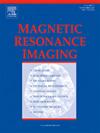相干血流对ivim灌注测量的影响:3 T的幻像研究。
IF 2
4区 医学
Q2 RADIOLOGY, NUCLEAR MEDICINE & MEDICAL IMAGING
引用次数: 0
摘要
定量、无创的灌注测量在MRI中仍然是一个挑战。基于弥散加权成像(DWI)的体素内非相干运动(IVIM)技术,通过将血流建模为微血管网络中的伪弥散过程,提供了一种在亚体素水平估计灌注的方法。关键的ivim衍生参数包括灌注分数(f)和伪扩散系数(D*)。虽然在特定的结构假设下,IVIM可用于估计脑血流量(CBF),但从IVIM指标到CBF的直接转换很少得到验证。本研究探讨了基于ivim的灌注测量的准确性,探讨了相干流对体素信号的影响。为了评估流量(地面真实CBF)、IVIM参数和计算CBF之间的关系,构建了一个由琼脂糖凝胶和管组成的模拟小动脉的模型,并调节流速。因此,IVIM模型中用D*表示的“快速”隔室的信号分数,由占据成像体素的固定分数的管中的流量表示,模拟所需的脑血容量(CBV)和CBF值。使用IVIM优化的DWI协议扫描假体,并处理数据以进行IVIM测量。除了IVIM,我们还提出了一个基于扩展Bloch-Torrey方程的模型。结果表明,IVIM可以在生理相关的血流范围(0.5-2 mm/s)内对脑血流和脑血流进行合理的估计。然而,在较高的速度下,特别是在动脉或静脉样流动条件下,观察到一致的流量高估(高达200 %)。本文章由计算机程序翻译,如有差异,请以英文原文为准。
Coherent flow effects on IVIM-based perfusion measurements: A phantom study in 3 T
Quantitative, non-invasive measurement of perfusion remains a challenge in MRI. The Intravoxel Incoherent Motion (IVIM) technique, based on Diffusion-Weighted Imaging (DWI), offers a method to estimate perfusion at the sub-voxel level by modeling blood flow as a pseudo-diffusive process within a microvascular network. Key IVIM-derived parameters include the perfusion fraction (f) and the pseudo-diffusion coefficient (D*). While under specific structural assumptions, IVIM can be used to estimate Cerebral Blood Flow (CBF), direct conversions from IVIM metrics to CBF are rarely validated. This study investigates the accuracy of the IVIM-based perfusion measures, exploring coherent flow influence on signal from voxel. To assess the relation between flow (ground truth CBF), IVIM parameters, and calculated CBF, a phantom, composed of agarose gel and tubes mimicking arterioles with regulated flow velocity, was constructed. Thus, a signal fraction from the “fast” compartment, described by D* in the IVIM model, is represented by flow in tubes occupying a fixed fraction of the imaged voxel, simulating desired Cerebral Blood Volume (CBV) and CBF values. The phantom was scanned using IVIM-optimized DWI protocol, and data were processed for the IVIM measures. Besides IVIM, we also propose a model based on extended Bloch-Torrey equations with coherent flow term. Results demonstrate that IVIM can yield reasonable estimates of CBF and CBV within physiologically relevant flow ranges (0.5–2 mm/s) observed in the brain vasculature. However, a consistent overestimation of flow (up to 200 %) was obscerved at higher velocities, especially in arterial or vein-like flow conditions.
求助全文
通过发布文献求助,成功后即可免费获取论文全文。
去求助
来源期刊

Magnetic resonance imaging
医学-核医学
CiteScore
4.70
自引率
4.00%
发文量
194
审稿时长
83 days
期刊介绍:
Magnetic Resonance Imaging (MRI) is the first international multidisciplinary journal encompassing physical, life, and clinical science investigations as they relate to the development and use of magnetic resonance imaging. MRI is dedicated to both basic research, technological innovation and applications, providing a single forum for communication among radiologists, physicists, chemists, biochemists, biologists, engineers, internists, pathologists, physiologists, computer scientists, and mathematicians.
 求助内容:
求助内容: 应助结果提醒方式:
应助结果提醒方式:


